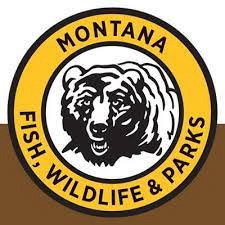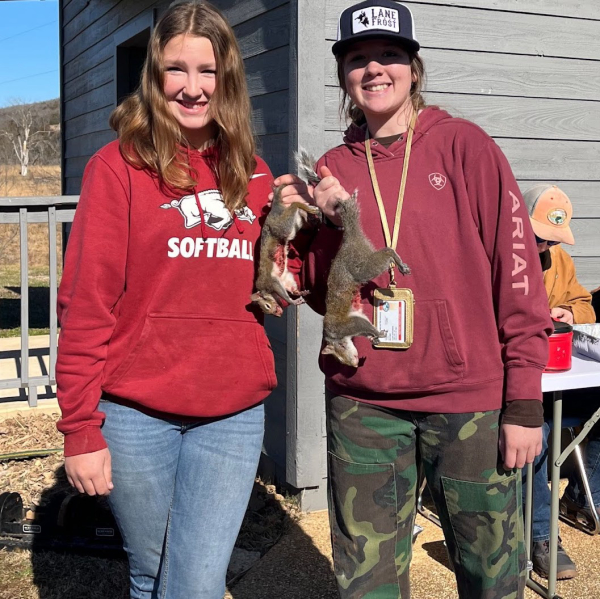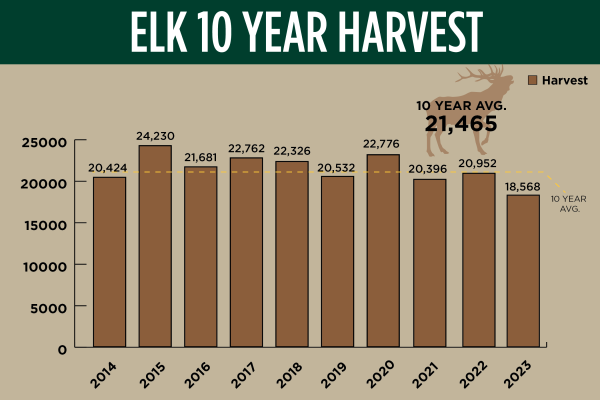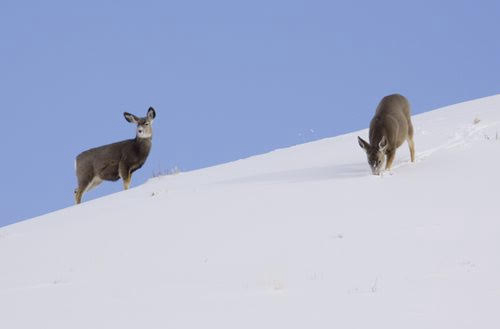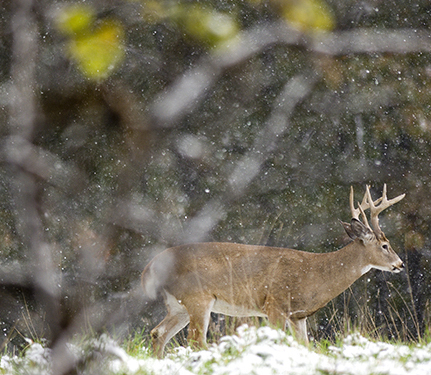U.P. Focus: Firearm deer hunting season a mixed bag in the Upper Peninsula
Michigan Department of Natural Resources wildlife biologists said preliminary check station data shows mixed results for the firearm deer hunting season in the Upper Peninsula.
So far, indications are there was a drop in the overall harvest. However, with hunters across the region registering a higher proportion of mature bucks, many of those deer were beautiful bucks.
After three consecutive severe winters in the region, DNR biologists predicted hunters this firearm deer season would likely see fewer deer in the U.P., especially in the 1 ½- and 2 ½-year-old age classes.
“It was a challenging firearm deer hunting season, as anticipated,” said David Jentoft, a DNR wildlife biologist at the Sault Ste. Marie Field Office. “The number of bucks being checked is generally down, but check stations have seen a higher proportion of mature bucks coming in, particularly 3 ½- and 4 ½-year-olds.”
DNR biologists expected more mature bucks in the harvest, with the effects of the previous year’s harsh winter weather limiting the number of yearling bucks available in the U.P. deer population this year.
Early Statistics
Preliminary estimates indicate deer check stations in the U.P. registered deer totals down about 13.5 percent through the firearm deer hunting season, compared to last year.
Check station results are only one indicator the DNR uses to evaluate the deer season and not all of that data has been compiled yet. A clearer picture of the season is expected to emerge once camp and hunter surveys are returned in the weeks ahead.
 The DNR check station at Escanaba was the busiest in the U.P., followed by Marquette. Escanaba staff checked a total of 321 deer and there were 165 deer checked at Marquette.
The DNR check station at Escanaba was the busiest in the U.P., followed by Marquette. Escanaba staff checked a total of 321 deer and there were 165 deer checked at Marquette.
The percentage of bucks checked at those two stations varied widely, demonstrating the limitation of projecting general results across the region from individual stations. The Escanaba station was down about 25 percent from last year, while Marquette had an increase of 20 percent.
A similar situation occurred at the Mackinac Bridge.
DNR wildlife division staff checked a total of 37 deer over the two days the check station at Bridge View Park in St. Ignace was open, compared to 51 there last year. That marks a dip of 27 percent.
However, a short distance away, Mackinac Bridge Authority toll booth workers informally counted a total of 1,481 deer on southbound vehicles over the firearm deer hunting season. That total represents a 5-percent decline from the 1,563 deer tallied last year.
Deer Health Improvement
Antler beam measurements, which generally indicate a buck’s overall fitness level, were greatly improved in the U.P. from the past two seasons.
“This shows that deer that came out of last winter were in pretty good shape, certainly better than the previous couple of seasons,” said Chad Stewart, DNR deer, elk and moose management specialist at the Rose Lake Wildlife Research Center in East Lansing. “Yearling antler beam growth is back now within the previous 10-year average after being significantly lower the last two years.”
Wolves
Wolves have an impact on the deer population in the U.P., but to what extent is not fully known.
A multiyear predator-prey study — being conducted by the DNR and Mississippi State University — is ongoing in an effort to better understand the predatory impacts to U.P. deer from wolves, coyotes, bears and bobcats.
Coyotes also play a significant role in deer predation. An individual wolf may kill more deer than a coyote. However, there are more coyotes on the landscape, which produces a larger impact on fawn mortality.
The predator-prey research has been conducted over the past six years in low and medium snowfall zones in the region and is moving north to study high snowfall areas next.
Wolves in Michigan are currently federally protected as endangered species after a U.S. District Court ruling in December 2014.
Endangered species status for the wolf severely limits the tools the state can use to manage the species, including lethal control, as outlined in the state’s Wolf Management Plan. The federal court ruling prohibits the Michigan Natural Resources Commission from considering hunting as a management tool.
manage the species, including lethal control, as outlined in the state’s Wolf Management Plan. The federal court ruling prohibits the Michigan Natural Resources Commission from considering hunting as a management tool.
The DNR supports removing wolves from the endangered species list, as gray wolves reached targeted population recovery goals in Michigan, Minnesota and Wisconsin years ago.
Legislation is currently pending in the U.S. Congress which, if passed into law, would prohibit courts from overruling the Department of the Interior on delisting wolves in Michigan, Minnesota, Wisconsin and Wyoming. A similar measure was passed in 2011 for wolves in Idaho and Montana.
Meanwhile, the DNR continues to manage wolves according to the remaining provisions of Michigan’s recently updated Wolf Management Plan, including the use of nonlethal harassment techniques.
The only legal killing of wolves in Michigan is in defense of human life.
Continuing Action
The DNR, NRC and sporting groups continue to partner in efforts to improve the deer population.
Long-range work is being done to preserve and enhance critical winter range areas by the U.P. Wildlife Habitat Work Group and short-range measures have been undertaken to try to preserve a larger number of does surviving the winter, including reducing the number of antlerless tags available to hunters in the U.P.
This past summer, the NRC eliminated the ability to tag an antlerless deer with either the single deer license or combination deer license during the archery season in hopes this may assist in helping the deer herd recover.
That change was expected to reduce the deer harvest by 5,000 to 6,000 deer heading into the winter months. The decision came after extensive discussions and public comment on six potential regulation change options for this fall.
Those options the NRC considered included:
- Option 1: Maintain the current hunting season and license structure in the U.P.
- Option 2: Close the entire deer hunting season in the U.P.
- Option 3: Eliminate the option of using a combination license when hunting in the U.P. (one buck) and eliminate the antlerless option during archery season when using the single deer license.
- Option 4: Eliminate the antlerless option during archery season for hunters hunting on deer licenses, including the combination license.
- Option 5: Eliminate the antlerless option for archers hunting on deer licenses, including the combination license, during the late archery season only.
- Option 6: Eliminate the Liberty and Independence hunts in the U.P.
“The reduced harvest in the U.P., though disappointing for many, will help aid in the long-term recovery of the deer herd, as well as the efforts being made to improve habitat,” Stewart said. “We know the deer numbers in the U.P. are down lower than most want to see. However, an elevated harvest would not be conducive to our goals at this time, which is to grow the deer herd in the U.P.”
Weather
The firearm deer hunting season opened Nov. 15 to unseasonably warm temperatures in the 50s across the U.P. By mid-season, temperatures had cooled and many places received snowfall. But by Monday’s season close, snow had melted from most areas.
“While we know deer numbers are low and we have taken several steps to help the herd recover, the most important component will be the weather,” said Ashley Autenrieth, DNR Deer Program biologist in Gaylord. “Luckily, this fall and going into this winter, we’ve seen above-average temperatures and very low snowfall levels. If the trend continues, we should see a mild winter which would be a great start to allowing the deer herd to recover.”
License Sales
Deer hunting license sales by county of residence were down about 10 percent in the  U.P. since March 1. As of Monday’s season close, there had been 63,202 deer hunting licenses sold to U.P. residents, compared to 70,154 last year.
U.P. since March 1. As of Monday’s season close, there had been 63,202 deer hunting licenses sold to U.P. residents, compared to 70,154 last year.
Marquette County had the highest number of residents buying deer licenses in the U.P. this year with 10,921, followed by Delta County with 9,975 and Menominee County with 9,298.
Muzzleloader and Late Archery Seasons
Muzzleloader season opens today in the U.P. and northern Lower Peninsula and closes Dec. 13. Late archery season opened Dec. 1 and continues through the end of the month. Prospects for hunters continue to remain mixed.
“Hunters still should not expect to see many deer, but those who are lucky enough to harvest a buck will likely be harvesting a 3 ½- to 4 ½-year-old buck since their numbers appear to be higher than younger age classes, due to the severe winters over the last few years,” Autenrieth said.
For more information on deer hunting in Michigan, visit the DNR’s webpage at: www.michigan.gov/deer.



